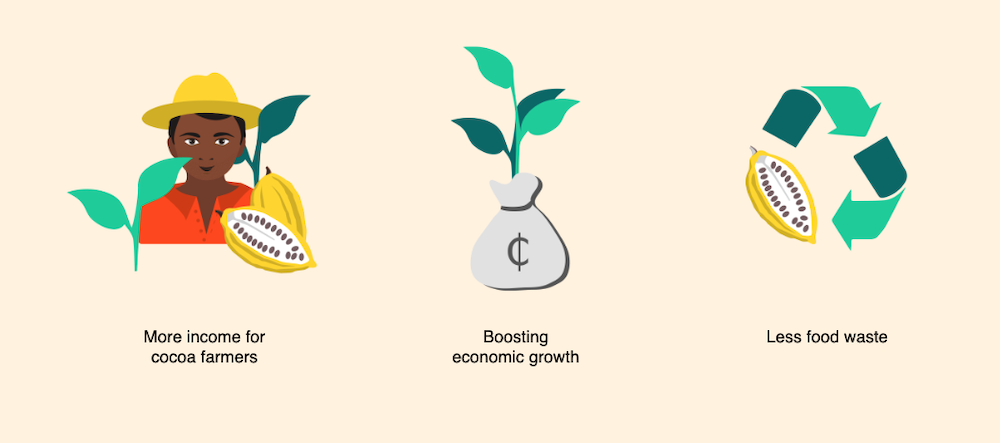Chef Elena at Chocoa 2020: Innovation, inspiration and insights make chocolate a sweeter deal for cocoa farmers

Chocoa is an annual fine chocolate and cocoa exposition held in each February in Amsterdam. It is based on a series of events bringing together all the members of the supply chain – farmers, cooperative representatives, traders, chocolate makers, chefs, start-ups and investors – who gather to discuss the challenges of the fine-cocoa world today.
Due to the wide variety of activities and venues at the exposition, this post shall solely highlight some savvy food-tech initiatives present at the Trade Fair, a venue where businesses of the cocoa world present their products and services.
Farmerline
Chocolate begins with the farmer and his empowerment is key to his prosperity. Farmerline, a company that helps small farmers grow into successful entrepreneurs, develops tailored solutions to increase cocoa producers’ access to resources and improve their visibility in supply chains.
“Most of the times, the farmer doesn’t have the necessary knowledge of the markets as well as of the value of their produce. This is what we are trying to change,” said Worlali Senyo, senior consultant and development researcher at Farmerline. The main target is helping farmers directly in 22 districts in Ghana as well as indirectly via partner companies in 24 countries around the world live to their full potential.
Mergdata, the company’s supply chain analytics platform, has empowered more than 300,000 farmers on their way to more sustainable production by giving them access to the markets and education programs. In 2020, the goal is to reach the mark of 400,000 farmers served thanks to the platform, as well as find opportunities to reach out to cocoa growers in Asia and South America.
Careful selection of the beans and their transformation are as crucial in top-notch chocolate fabrication as the well-being of a farmer. Fermentation and roasting, the two parts of the same pathway towards to the development of the desired aromatic and flavour profile, are tricky due to their complexity and multi-factorial nature and may sometimes result in (un)pleasant surprises.
LalCocoa
Lallemand, a Canadian research institution, launched LalCocoa, a series of specific yeasts that enhance the quality of cocoa beans during the fermentation process. Tests on beans from French Guiana conducted in 2017 have demonstrated less astringency and bitterness as well as better developed fruity notes compared to the same beans fermented without LalCocoa.
One of the main advantages of the yeast proposed, according to Camille Duez, global technical support specialist at Lallemand, is “the possibility of speeding up and stabilizing the fermentation process in the beans as well as bringing out some of the sought-after characteristics among the manufacturers such as a fruitier and more intense cocoa flavour.”
Such a solution may be of interest for the medium and large scale players on the market who wish to achieve a considerable regularity in cocoa production and may be less of interest for small producers who might want to look for specific aroma and flavour notes which may be suppressed during the fermentation with the LalCocoa yeast.

Koa
Zero-waste businesses and solutions have conquered a fair share of the “green” market in Europe over the past few years. No wonder, since for most European countries waste management, including food waste, is one of the top priorities for city, town and village councils. A Swiss initiative called Koa has become a pioneer in applying such waste-free philosophy to cocoa by extracting juice from the jelly surrounding cocoa beans just as they are taken out from the pod in Africa.
“Extraction should happen no longer than two hours after the pods are split open, and the juice is to be pasteurized in the two hours that follow at very low temperature,” said Matthias Göhler, the company’s sales director. “Currently we have one mobile unit that runs on solar power to perform the extraction, which is practical in the conditions of Ghanian rainforest (where the company is operating today – E.K.) and we are looking forward to investing into building another one soon,” added Matthias added.
The goal is not only to surprise people with the juice’s unique taste, but also incite substantial social and environmental change in the community. Using cocoa pulp to make Koa Pure juice helps farmers increase their earnings by 30 percent and turns it into a second source of income for some of them which improves the families’ financial situations and brings prosperity to the region.
One small step for man, one bottle of juice, one farmer who gets access to the market, one family who joins the cooperative ….
Hopefully with those initiatives launched towards fairer cocoa and thus greater chocolate, this thousand or even million leagues journey will not seem unattainable in the end.
About the author:
Elena Kalmykova is a pastry chef, gastronomic guide, arts lover and passionate traveller living in Paris. She’s originally from Moscow, Russia. It was her love for pastry that led Elena to study and then work in a Parisian pastry shop, a 3-star Michelin restaurant and now in a 5-star hotel.
She loves to discover new technologies as well as the latest trends in food, great spots to eat or drink and share her knowledge.
You can follow her on Instagram at elena_kalmykova.
The post Chef Elena at Chocoa 2020: Innovation, inspiration and insights make chocolate a sweeter deal for cocoa farmers appeared first on Dispatches Europe.
